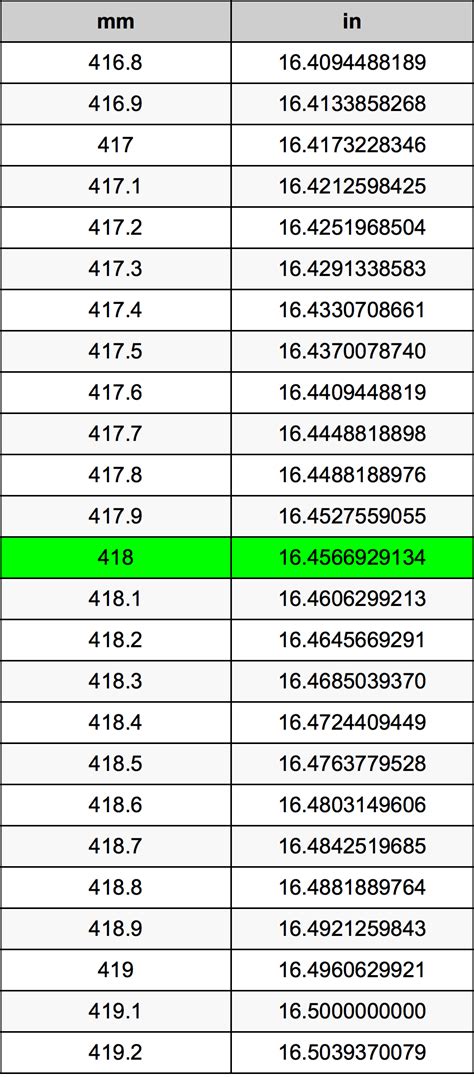Convert 418 mm to Inches: Unraveling the Metric Mystery

418 mm in Inches: A Comprehensive Exploration
The metric system, an internationally recognized system of measurement, has gained widespread acceptance as the standard for scientific and technical applications. Within this system, the millimeter (mm) serves as a fundamental unit of length. In certain contexts, however, it becomes necessary to convert millimeters to inches, a unit commonly used in imperial and US customary systems.
Understanding Millimeters and Inches
Millimeters: The millimeter (mm) is a unit of length in the metric system equal to one-thousandth of a meter (1 mm = 10^-3 m). It is widely employed in scientific measurements, engineering drawings, and various industries.
Inches: An inch (in) is a unit of length in the imperial and US customary systems, defined as one-twelfth of a foot (1 in = 1/12 ft). It is commonly used in everyday measurements, construction, and certain industries.
Conversion Formula: Millimeters to Inches
The conversion between millimeters and inches is straightforward, utilizing a simple formula:
1 inch = 25.4 millimetersThis formula serves as the foundation for converting millimeters to inches. To convert a measurement in millimeters to inches, simply multiply the millimeter value by 25.4.
Converting 418 mm to Inches
To convert 418 mm to inches, apply the conversion formula:
418 mm = 418 mm × (1 inch / 25.4 mm)Calculating the result:
418 mm = 16.46 inchesTherefore, 418 millimeters is equivalent to 16.46 inches.
Applications of Millimeters and Inches
Millimeters:
- Scientific measurements (e.g., laboratory experiments, microscopic observations)
- Engineering drawings (e.g., mechanical designs, architectural plans)
- Medical applications (e.g., measuring blood pressure, drug dosages)
- Precision manufacturing (e.g., electronics, automotive parts)
Inches:
- Everyday measurements (e.g., height, length, width)
- Construction (e.g., lumber dimensions, plumbing fixtures)
- Hardware and tools (e.g., screw sizes, wrench sizes)
- Sports and athletics (e.g., measuring distances, equipment specifications)
Advantages and Disadvantages of Millimeters and Inches
Millimeters:
Advantages:- Metric system's standardized unit
- Consistent and decimal-based system
- Globally recognized and widely used
- Less familiar in certain countries (e.g., US, UK)
- Conversion required for imperial/US customary systems
Inches:
Advantages:- Familiar unit in many countries
- Widely used in everyday measurements
- Inconsistent system with various definitions (e.g., inch, foot, yard)
- Less precise for scientific and engineering applications
Conclusion
The conversion between millimeters and inches is essential for various applications, ranging from scientific research to everyday measurements. Understanding the conversion formula and the advantages and disadvantages of both units enables effective communication and accurate calculations across different measurement systems.